ESP Citroen DS3 2011 1.G Owner's Guide
[x] Cancel search | Manufacturer: CITROEN, Model Year: 2011, Model line: DS3, Model: Citroen DS3 2011 1.GPages: 324, PDF Size: 25.11 MB
Page 165 of 324
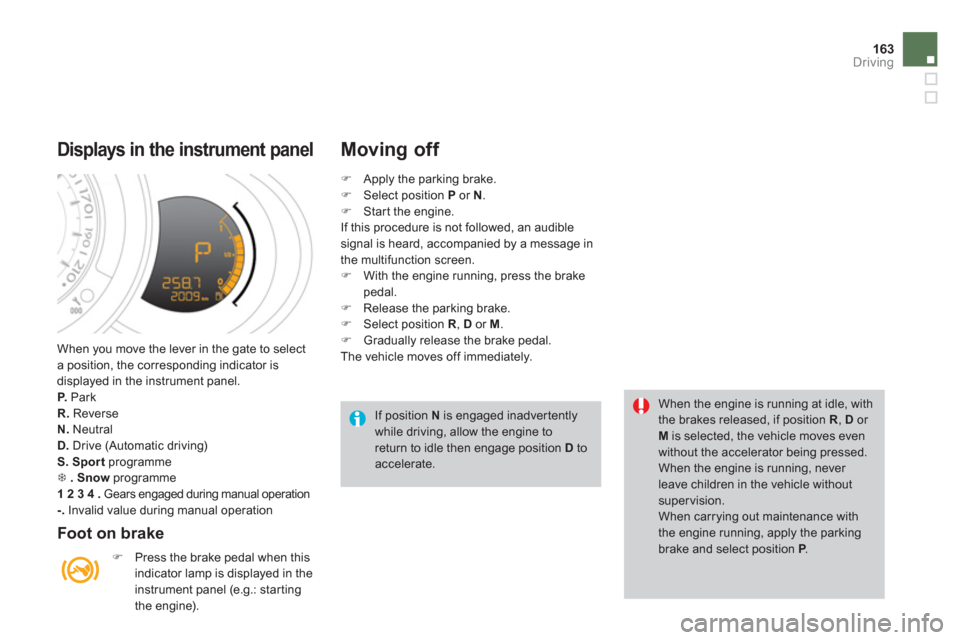
163Driving
When you move the lever in the gate to select
a position, the corresponding indicator is
displayed in the instrument panel.
P.
Park
R.
Reverse
N.
Neutral
D.
Drive (Automatic driving)
S.
Sport
programme
�7
.
Snow
programme
1 2 3 4
.
Gears engaged during manual operation
-.
Invalid value during manual operation
Displays in the instrument panel
Foot on brake
�)
Press the brake pedal when this
indicator lamp is displayed in the
instrument panel (e.g.: starting
the engine).
Moving off
If position N
is engaged inadvertently
while driving, allow the engine to
return to idle then engage position D
to
accelerate. When the engine is running at idle, with
the brakes released, if position R
, D
or
M
is selected, the vehicle moves even
without the accelerator being pressed.
When the engine is running, never
leave children in the vehicle without
supervision.
When carrying out maintenance with
the engine running, apply the parking
brake and select position P
.
�)
Apply the parking brake.
�)
Select position P
or N
.
�)
Star t the engine.
If this procedure is not followed, an audible
signal is heard, accompanied by a message in
the multifunction screen.
�)
With the engine running, press the brake
pedal.
�)
Release the parking brake.
�)
Select position R
, D
or M
.
�)
Gradually release the brake pedal.
The vehicle moves off immediately.
Page 171 of 324
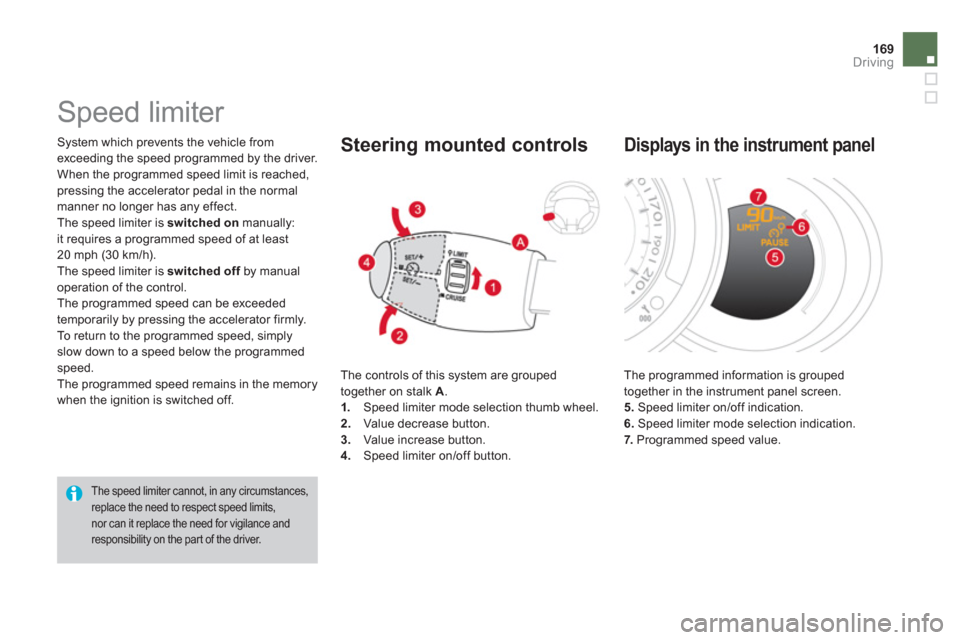
169Driving
System which prevents the vehicle from
exceeding the speed programmed by the driver.
When the programmed speed limit is reached,
pressing the accelerator pedal in the normal
manner no longer has any effect.
The speed limiter is switched on
manually:
it requires a programmed speed of at least
20 mph (30 km/h).
The speed limiter is switched off
by manual
operation of the control.
The programmed speed can be exceeded
temporarily by pressing the accelerator firmly.
To return to the programmed speed, simply
slow down to a speed below the programmed
speed.
The programmed speed remains in the memory
when the ignition is switched off.
Speed limiter
The speed limiter cannot, in any circumstances,
replace the need to respect speed limits,
nor can it replace the need for vigilance and
responsibility on the part of the driver.
The controls of this system are grouped
together on stalk A
.
1.
Speed limiter mode selection thumb wheel.
2.
Value decrease button.
3.
Value increase button.
4.
Speed limiter on/off button.
Steering mounted controls
The programmed information is grouped
together in the instrument panel screen.
5.
Speed limiter on/off indication.
6.
Speed limiter mode selection indication.
7.
Programmed speed value.
Displays in the instrument panel
Page 173 of 324

171Driving
Cruise control
System which automatically maintains the
speed of the vehicle at the value programmed
by the driver, without any action on the
accelerator pedal.
The cruise control is switched on
manually: it
requires a minimum vehicle speed of 25 mph
(40 km/h), as well as the engagement of:
- four th gear on a manual gearbox,
- second gear on a SensoDrive or automatic
gearbox, in sequential mode,
- position A
on a SensoDrive gearbox or
position D
on an automatic gearbox.
The cruise control is switched off
manually
or by pressing the brake or clutch pedal or
on triggering of the ESP system for safety
reasons.
It is possible to exceed the programmed speed
temporarily by pressing the accelerator pedal.
To return to the programmed speed, simply
release the accelerator pedal.
Switching off the ignition cancels any
programmed speed value. The controls of this system are grouped
together on stalk A
.
1.
Cruise control mode selection thumb
wheel.
2.
Value decrease button.
3.
Value increase button.
4.
Cruise control off/resume button.
Steering mounted controls
The cruise control cannot, in any circumstances,
replace the need to respect speed limits,
nor can it replace the need for vigilance and
responsibility on the par t of the driver.
The programmed information is grouped
together in the instrument panel screen.
5.
Cruise control off/resume indication.
6.
Cruise control mode selection indication.
7.
Programmed speed value.
Displays in the instrument panel
Page 175 of 324
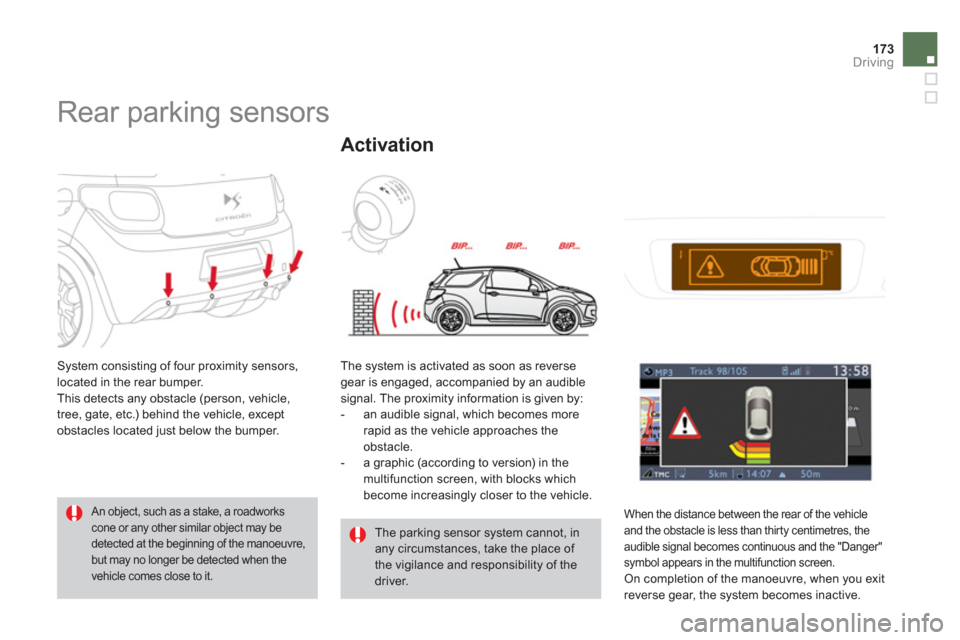
173Driving
Rear parking sensors
System consisting of four proximity sensors,
located in the rear bumper.
This detects any obstacle (person, vehicle,
tree, gate, etc.) behind the vehicle, except
obstacles located just below the bumper.
An object, such as a stake, a roadworks
cone or any other similar object may be
detected at the beginning of the manoeuvre,
but may no longer be detected when the
vehicle comes close to it.
The parking sensor system cannot, in
any circumstances, take the place of
the vigilance and responsibility of the
driver. The system is activated as soon as reverse
gear is engaged, accompanied by an audible
signal. The proximity information is given by:
- an audible signal, which becomes more
rapid as the vehicle approaches the
obstacle.
- a graphic (according to version) in the
multifunction screen, with blocks which
become increasingly closer to the vehicle.
Activation
When the distance between the rear of the vehicle
and the obstacle is less than thirty centimetres, the
audible signal becomes continuous and the "Danger"
symbol appears in the multifunction screen.
On completion of the manoeuvre, when you exit
reverse gear, the system becomes inactive.
Page 176 of 324
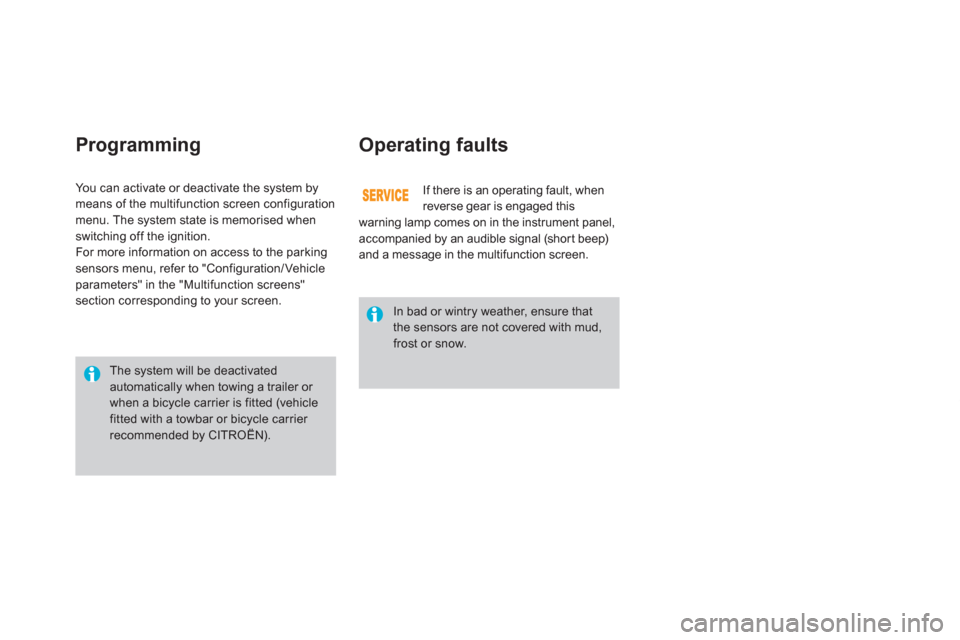
Programming
Operating faults
If there is an operating fault, when
reverse gear is engaged this
warning lamp comes on in the instrument panel,
accompanied by an audible signal (shor t beep)
and a message in the multifunction screen. You can activate or deactivate the system by
means of the multifunction screen configuration
menu. The system state is memorised when
switching off the ignition.
For more information on access to the parking
sensors menu, refer to "Configuration/ Vehicle
parameters" in the "Multifunction screens"
section corresponding to your screen.
The system will be deactivated
automatically when towing a trailer or
when a bicycle carrier is fitted (vehicle
fitted with a towbar or bicycle carrier
recommended by CITROËN). In bad or wintry weather, ensure that
the sensors are not covered with mud,
frost or snow.
Page 185 of 324
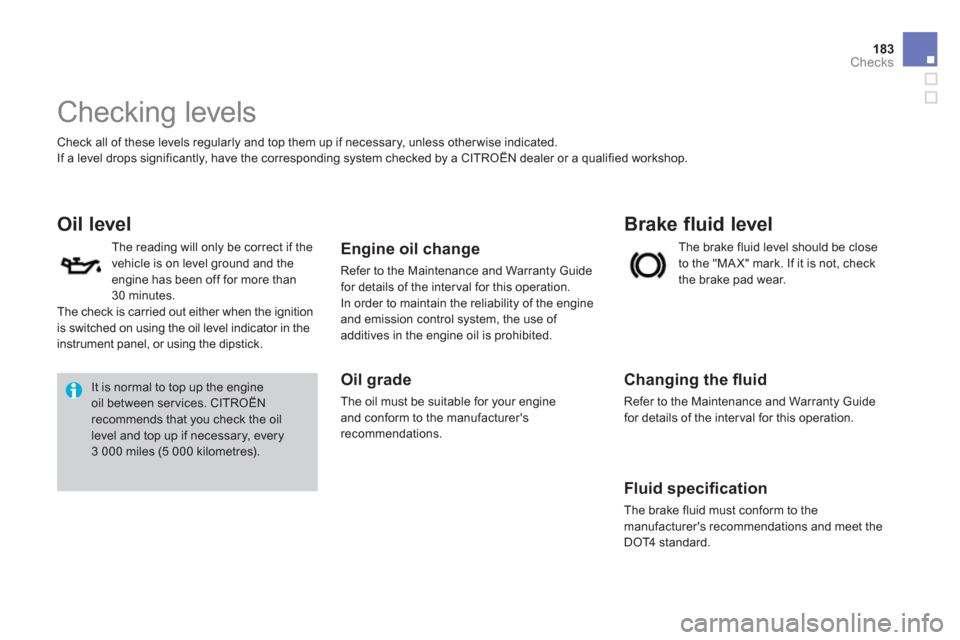
183Checks
Checking levels
Check all of these levels regularly and top them up if necessary, unless other wise indicated.
If a level drops significantly, have the corresponding system checked by a CITROËN dealer or a qualified workshop.
Oil level
Engine oil change
Refer to the Maintenance and Warranty Guide
for details of the inter val for this operation.
In order to maintain the reliability of the engine
and emission control system, the use of
additives in the engine oil is prohibited.
Oil grade
The oil must be suitable for your engine
and conform to the manufacturer's
recommendations.
Brake fluid level
Changing the fl uid
Refer to the Maintenance and Warranty Guide
for details of the inter val for this operation.
Fluid specifi cation
The brake fluid must conform to the
manufacturer's recommendations and meet the
DOT4 standard.
The brake fluid level should be close
to the "MA X" mark. If it is not, check
the brake pad wear. The reading will only be correct if the
vehicle is on level ground and the
engine has been off for more than
30 minutes.
The check is carried out either when the ignition
is switched on using the oil level indicator in the
instrument panel, or using the dipstick.
It is normal to top up the engine
oil between ser vices. CITROËN
recommends that you check the oil
level and top up if necessary, every
3 000 miles (5 000 kilometres).
Page 209 of 324

207Practical information
1.
Brake lamps/sidelamps (P21/5W).
2.
Sidelamps (P5W).
3.
Direction indicators (PY21W amber)
4.
Foglamp,
offside
(PR21W red)
Reversing lamp,
nearside
(P21W).
Rear lamps
Amber or red bulbs, such as those
for the direction indicators and rear
foglamp, must be replaced by bulbs of
the same rating and colour.
Changing bulbs
�)
Open the boot.
�)
Remove the access flap from the
corresponding side trim panel.
�)
Unscrew the butter fly nut securing the
lamp unit.
�)
Unclip the lamp unit connector.
�)
Extract the lamp unit carefully pulling in its
middle towards the outside.
�)
Spread the four tabs and remove the bulb
holder.
�)
Turn the bulb a quar ter of a turn and
change it.
To refit, carry out these operations in reverse
order.
Take care to engage the lamp unit in its guides,
while keeping it in line with the vehicle.
Page 212 of 324

Changing a fuse
Installing electrical
accessories
Your vehicle's electrical system is
designed to operate with standard or
optional equipment.
Before installing other electrical
equipment or accessories on your
vehicle, contact a CITROËN dealer or a
qualified workshop.
CITROËN will not accept responsibility
for the cost incurred in repairing your
vehicle or for rectifying malfunctions
resulting from the installation of
accessories not supplied and not
recommended by CITROËN and
not installed in accordance with its
instructions, in par ticular when the
combined consumption of all of the
additional equipment connected
exceeds 10 milliamperes.
The extraction pliers and the spare fuse
storage locations are fitted to the back of the
dashboard fuse box cover.
For access to them:
�)
unclip the cover by pulling on the side,
�)
remove the cover completely,
�)
remove the pliers.
Access to the tools
Before changing a fuse,
the cause of the failure must be identified
and rectified.
�)
Identify the faulty fuse by checking the
condition of its filament.
Changing a fuse
Good
Failed
�)
Use the special tweezer to extract the fuse
from its housing.
�)
Always replace the faulty fuse with a fuse
of the same rating.
�)
Check that the number marked on the
box, the rating marked on the fuse and the
tables below all agree.
Page 215 of 324

213Practical information
Engine compartment
fusebox
The fusebox is located in the engine
compartment near the battery (left-hand side).
Access to the fuses
�)
Unclip the cover.
�)
Change the fuse (see corresponding
paragraph).
�)
When you have finished, close the cover
carefully to ensure the sealing of the fuse
box.
All work on the fuses in the box
located on the battery, must be done
by a CITROËN dealer or a qualified
workshop.
Page 216 of 324
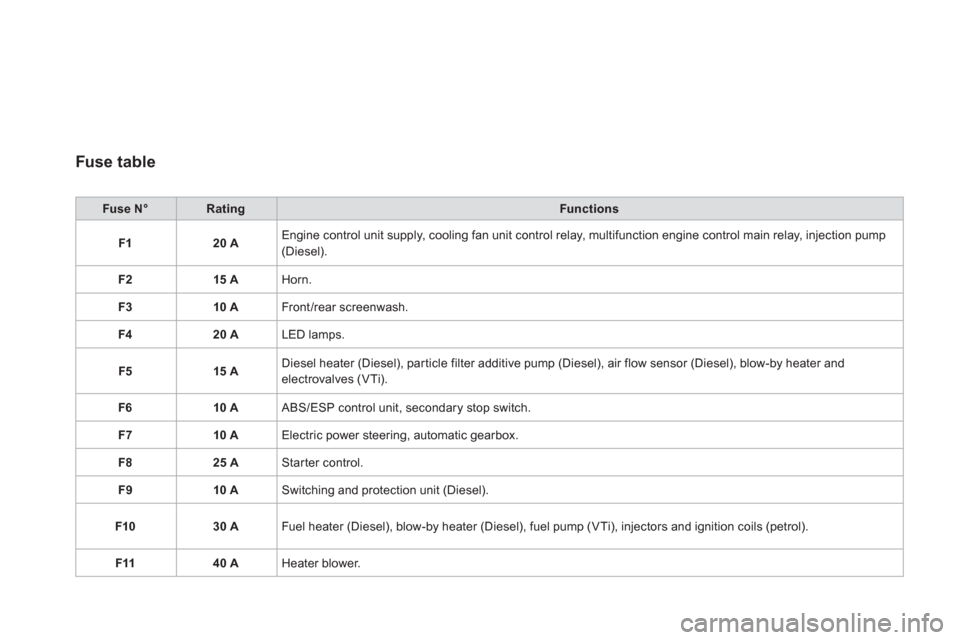
Fuse table
Fuse N°
Rating
Functions
F1
20 A
Engine control unit supply, cooling fan unit control relay, multifunction engine control main relay, injection pump
(Diesel).
F2
15 A
Horn.
F3
10 A
Front/rear screenwash.
F4
20 A
LED lamps.
F5
15 A
Diesel heater (Diesel), par ticle filter additive pump (Diesel), air flow sensor (Diesel), blow-by heater and
electrovalves (VTi).
F6
10 A
ABS/ESP control unit, secondary stop switch.
F7
10 A
Electric power steering, automatic gearbox.
F8
25 A
Starter control.
F9
10 A
Switching and protection unit (Diesel).
F10
30 A
Fuel heater (Diesel), blow-by heater (Diesel), fuel pump (VTi), injectors and ignition coils (petrol).
F11
40 A
Heater blower.